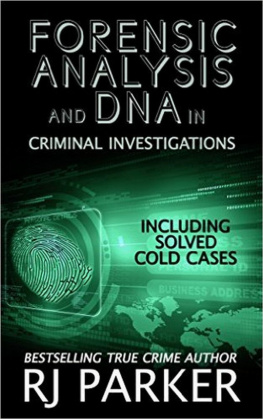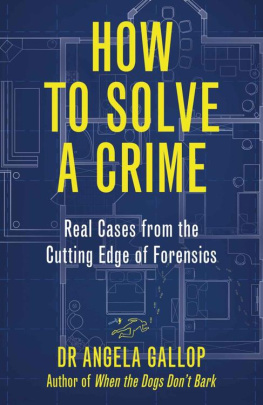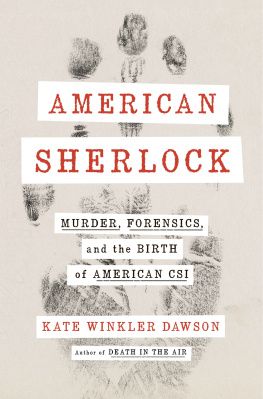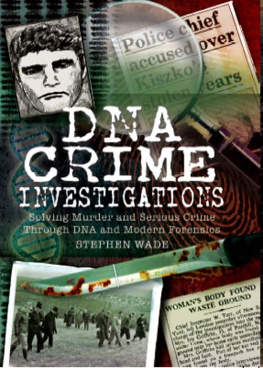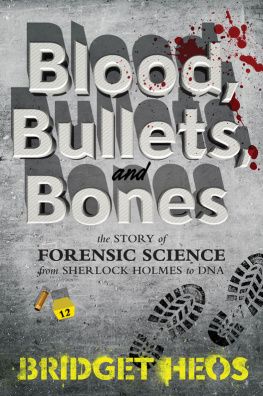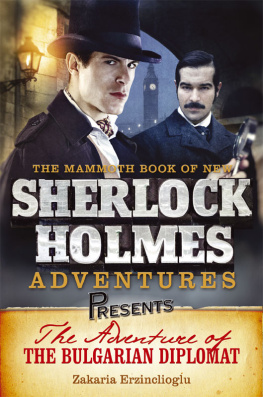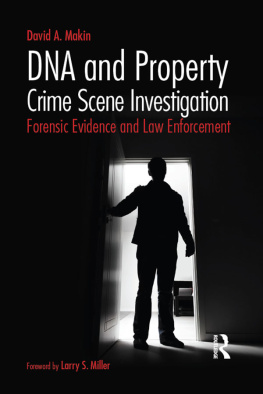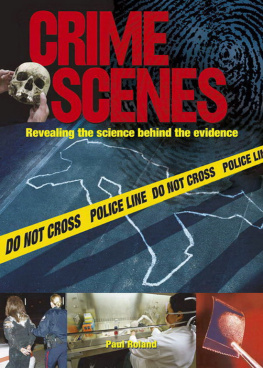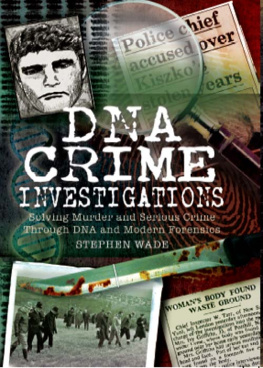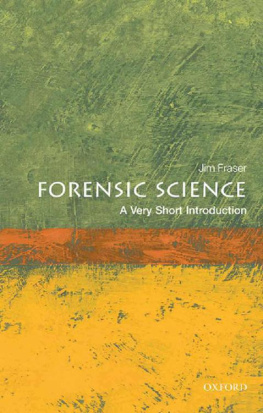
The author and publisher have provided this e-book to you for your personal use only. You may not make this e-book publicly available in any way. Copyright infringement is against the law. If you believe the copy of this e-book you are reading infringes on the authors copyright, please notify the publisher at: us.macmillanusa.com/piracy.
Contents
FOR
LEWIS DAVIES,
HENRY DISNEY
AND
IAN GAULD
THE THREE
ENTOMOLOGISTS
WHO MOST
INFLUENCED
MY CAREER
Foreword
The alliterative title of Dr Erzinliolus book is very apt indeed, for it displays the three essential elements of his fascinating memoirs, which are mixed in a way which holds the attention throughout.
The author is known with considerable respect and some affection as Dr Zak by every police force in the country and I have had the privilege of knowing him for many years. Some of the cases we have shared appear in these pages and I especially remember Karen Price, the body in the carpet, probably the most forensically-satisfying investigation of my own career. Others included the tragic double shooting on the Pembrokeshire cliffs and the body in the West Country barley-field where Zaks opinion threw the rest of us into confusion, until an unusual scientific solution calmed the troubled waters!
This book is no mere recital of half a life-times case-work the pages are laced through with scientific fact, philosophical debate, historical asides and political campaigning as far as the legal system is concerned.
It is typical of the author himself, for Dr Zak is a big man large in body, mind and soul, with a commanding presence. I occasionally felt that he was born a few hundred years too late, as he reminded me of those seventeenth-century Royal Society polymaths, with his wide-ranging interests in so many subjects. His book brings this out perfectly, with its compelling amalgam of entomology, criminology, history and as important as the science humanity, for he succeeds in bridging what would appear to be an unbridgeable gap between bluebottle maggots and a social conscience! Yet along with details of the house-flys life-cycle, he remembers to describe the frequent squalor of the sordid premises so familiar to all forensic specialists that have to attend scenes of death and where, as Dr Zak so eloquently points out, human beings have to survive alongside the flies.
It might seem rather odd that a world expert on the blow-fly should write a book that is informative, intriguing, astonishing and yet show such compassion and not a little anger at deprivation and injustice yet, for those who know Dr Zak, it is no real surprise at all.
Bernard Knight, CBE,
Emeritus Professor of Forensic Pathology,
University of Wales
Authors acknowledgements
I particularly wish to mention the late Professors Cedric Keith Simpson and Alan Usher. These two distinguished pathologists were responsible for my entry into the world of forensic science and my gratitude to them is immense. Of the many other forensic pathologists who have done everything they could to support my work, I would like to thank Professors Anthony Busuttil, David Gee, Michael Green, Austin Gresham, Bernard Knight and Peter Vanezis, and Dr Basil Purdue.
I also wish to give special thanks to Mr Alex Carlile, Q.C., formerly Member of Parliament for Montgomery and now Lord Carlile of Berriew, for his staunch support and encouragement over many years.
My thanks are also due to Lord Ferrers, formerly Minister of State at the Home Office, for his help in securing Home Office funding for my work and for his unfailing personal courtesy.
For the development of the entomological aspects of my career, I am greatly in the debt of Drs Lewis Davies, Henry Disney and Ian Gauld who, more than any of the many other entomologists I know, have supported me and over the years put up with my eccentricities. I know that, on occasion, I have tried them sorely.
Specifically in the realm of forensic entomology, I would like to thank Professor Bernard Greenberg and Mr Ken Smith for their friendship and advice.
My colleagues at the Forensic Science Service are too numerous to mention individually, but I would like to give special thanks to Dr Trevor Rothwell, Mr Peter Lamb, Mr Philip Toates, Dr Ann Davies, Mr Graham Craddock, Mrs Elizabeth Wilson and Mr Frank Gore.
Much of my career was spent working at the Department of Zoology, University of Cambridge, and, in this connection, I would like to thank, and acknowledge gratefully the support of, Professor Gabriel Horn, Professor Malcolm Burrows, Dr Ken Joysey, Professor Patrick Bateson and Dr William Foster. Of the very many other members of that large and bustling department who made my time there both pleasant and intellectually rewarding, I would like to give special thanks to Professor Michael Bate, Professor Simon Laughlin, Dr Helen Skaer and Mr Dennis Unwin, all of whom took a kind interest in my work.
With regard to my concerns about the role of forensic science in the administration of justice, I wish to acknowledge with gratitude the time and patience with which the late Lord Dainton considered my views. I also thank Lord Lewis for listening to my concerns in this area and for his great personal courtesy.
I wish to thank Jonathan Clowes Ltd for permission to reproduce extracts from Sir Arthur Conan Doyles Sherlock Holmes stories.
I thank Dr Michael Roberts for preparing the imaginative illustrations, which so enhance the books appearance. My thanks also to Annette and Basil Harley, who went through the text with a fine-toothed comb, curbing my natural verbosity and saving me from making a number of embarrassing errors. I also thank Dr Susan Leech for preparing the index.
My wife, Sharon, and my children, Tanya, Larissa and Aksel, have all encouraged me during the writing of the book and their delight at its completion was my greatest reward. I particularly wish to thank my wife for her painstaking efforts in editing the book; and my children for doing their share of the work.
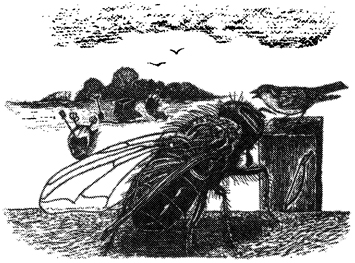
CHAPTER 1
A very simple clue
Who saw him die?
I, said the Fly
With my little eye,
I saw him die.
Anon., Who killed Cock Robin?
Viewed dispassionately, a dead human body is a magnificent and highly nutritious resource. Such a resource, suddenly made available in Nature, will be rapidly colonized by various insects as well as other invertebrate animals. As time passes and decomposition progresses, different insect species will be attracted to the body at different stages of decay. Bluebottles and greenbottles will arrive to lay their eggs which hatch into maggots that feed voraciously on the tissues. Beetles will arrive, not only to feed upon the tissues, but also upon the maggots. Minute wasps will arrive to parasitize the maggots. Tiny flies, whose very existence remains unguessed by most people, will similarly arrive at various stages of decay and will leave tell-tale signs of their visits. Myriads of other creatures will arrive at various times, each to leave its mark for future interpretation by those who look into such things. On the basis of the fact that anything that changes with time can be used as a clock, the succession of insects occurring on a dead body can, in principle, be exploited as a measure of time since death.


